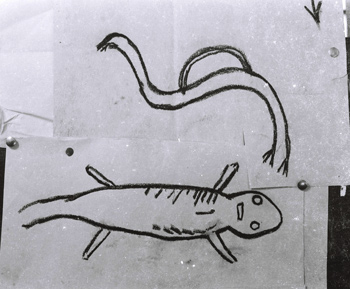Murch delivered a lecture to the Royal Art Society in 1978 which offers key insights into his ways of thinking and his influences. He screened his 1933-34 Central Australian film at the lecture and records his reactions to the drawings by people from the Petermann Ranges who he encountered on these early trips. These people – who had little experience (if any) of white people – were given charcoal and paper by Murch and he asked them to draw animals for him.

Murch writes in his lecture notes:
“The first drawing was Nature’s, the wind and water ripple, footprints in the sand.
Dawn man, speaking but a few words, hunting down his food could read the day’s menu. It is easy to imagine him teaching his children a creatures’ identity by finger-made tracks. When we asked an old man of Mt Liebig, Central Australia in 1934 to draw an emu, he drew its footprints. He was of the tribe quite unused to realist drawings. His creatures were identified by geometrical totemic symbols. So here we have stone age man about to make his first representational drawings. He knows now that it is the bird we want. He draws the upper outline of the bird, a side view. The key line of the identification of the quarry against the sky. This took many minutes. He was fatigued. His fellow huntsmen out of camera range tell him: ‘Draw his feet’. He pins them on the end of the tail and is well applauded. The under-side of the bird needs attention. He thickens it but does not seem aware that an under-side outline could be used……
I remember George Lambert’s advice on beginning a portrait, ‘Draw the top silhouette of the head carefully, it is the key to the likeness.’
Watch this lad draw. He is no novice. Fourteen years old, from 400 miles south- west near the Petermann Ranges. He has never seen white man before, nor white-man’s animals. But he knows his lizards.”
Read the complete notes for this lecture :
• 1978 Royal Art Society Lecture transcript
We made a film of painting techniques to accompany the lecture.